Preparation and NH4+ Adsorption Performance of Ultrafine Lignite-Based Porous Materials
Abstract
:1. Introduction
2. Materials and Methods
2.1. Materials
2.2. Grinding and Adsorption Experiments
2.3. Adsorption Modeling
2.3.1. Isotherm
2.3.2. Kinetics
2.4. Material Characterization
2.4.1. Particle Size Analysis
2.4.2. BET Analysis
2.4.3. SEM Analysis
2.4.4. Zeta Analysis
2.4.5. FTIR Analysis
2.4.6. XPS Analysis
3. Results and Discussion
3.1. Material Analysis
3.1.1. Particle Size Analysis
3.1.2. BET Analysis
3.1.3. SEM Analysis
3.2. Adsorption Experiment
3.2.1. Isothermal Adsorption Experiments
3.2.2. Adsorption Kinetics Experiments
3.2.3. Influence of pH on Adsorption and Zeta Potential
3.3. Adsorption Mechanism
3.3.1. FTIR Analysis
3.3.2. XPS Analysis
4. Conclusions
- (1)
- In the vertical stirring mill, the continuous collisions of zirconia balls with coal powder reduced particle size, created new micropores, and caused a significant collapse of existing macropores into mesopores and micropores. Following the milling process, a decrease in particle size is noted, leading to stronger cohesive forces between coal dust particles and resulting in denser agglomerates. This increased particle adhesion creates new porosity, including both mesopores and micropores. The increase in mesopores and micropores provides more adsorption sites, which improves the capacity to adsorb NH4+.
- (2)
- Adsorption capacity tests revealed that lignite milled for 50 min exhibited monolayer adsorption. For lignite milled for 50 min, both the adsorption rate and the time to reach equilibrium were slower compared to shorter milling times. Decreased pore size led to slower diffusion into pores, extending the time to achieve adsorption equilibrium, which resulted in higher adsorption capacity for lignite milled for 50 min compared to shorter milling times.
- (3)
- Prolonged milling time led to the exposure of more oxygen-containing functional groups, and samples milled for 50 min showed the highest electronegativity. With an increase in pH, the zeta potential of lignite decreased due to greater ionization of -OH and -COOH groups. Simultaneously, as H+ concentration in the solution decreased, competition for adsorption sites with NH4+ lessened, thus enhancing NH4+ adsorption onto the lignite.
- (4)
- FTIR and XPS analyses indicated that the -COOH functional groups on the coal surface readily underwent substitution by NH4+, forming COONH4. This polar substitution induced the exposure of more -COO groups on the surface, which were previously hidden within the coal’s molecular structure. Additionally, the hydrogen atoms in NH4+ likely formed adsorptive bonds with the oxygen atoms in C-O due to hydrogen bonding. Furthermore, a portion of NH4+ was also adsorbed onto the coal surface through electrostatic attraction. These three mechanisms collectively contributed to the increased adsorption capacity.
Author Contributions
Funding
Data Availability Statement
Conflicts of Interest
References
- Cai, Y.; Zhu, M.; Meng, X.; Zhou, J.L.; Zhang, H.; Shen, X. The Role of Biochar on Alleviating Ammonia Toxicity in Anaerobic Digestion of Nitrogen-Rich Wastes: A review. Bioresour. Technol. 2022, 351, 126924. [Google Scholar] [CrossRef] [PubMed]
- Badran, A.M.; Utra, U.; Yussof, N.S.; Bashir, M.J.K. Advancements in Adsorption Techniques for Sustainable Water Purification: A Focus on Lead Removal. Separations 2023, 10, 565. [Google Scholar] [CrossRef]
- Liu, W.; Zhang, Q.; Shen, Y.; Li, W.; Zhao, S.; Zhao, Q.; Zhang, Y. A Study on the Removal Characteristics and Mechanism of Phosphorus from Simulated Wastewater Using a Novel Modified Red-Mud-Based Adsorption Material. Separations 2023, 10, 562. [Google Scholar] [CrossRef]
- Ji, B.; Zhang, H.; Zhou, L.; Yang, J.; Zhang, K.; Yuan, X.; Ma, J.; Qian, Y. Effect of the Rapid Increase of Salinity on Anoxic-Oxic Biofilm Reactor for Treatment of High-Salt and High-Ammonia-Nitrogen Wastewater. Bioresour. Technol. 2021, 337, 125363. [Google Scholar] [CrossRef]
- Dalanta, F.; Kusworo, T.D. Synergistic Adsorption and Photocatalytic Properties of AC/TiO2/CeO2 Composite for Phenol and Ammonia-Nitrogen Compound Degradations from Petroleum Refinery Wastewater. Chem. Eng. J. 2022, 434, 134687. [Google Scholar] [CrossRef]
- Cui, H.; Ma, H.; Chen, S.; Yu, J.; Xu, W.; Zhu, X.; Gujar, A.; Ji, C.; Xue, J.; Zhang, C.; et al. Mitigating Excessive Ammonia Nitrogen in Chicken Farm Flushing Wastewater by Mixing Strategy for Nutrient Removal and Lipid Accumulation in the Green Alga Chlorella Sorokiniana. Bioresour. Technol. 2020, 303, 122940. [Google Scholar] [CrossRef] [PubMed]
- Velasco-Garduño, O.; Mendoza-Reséndiz, A.; Fajardo-Ortiz, C.; Beristain-Cardoso, R. Simultaneous Ammonia and Organic Matter Removal from Industrial Wastewater in A Continuous Novel Hybrid Carrousel Bioreactor. Int. J. Environ. Sci. Technol. 2019, 16, 3429–3436. [Google Scholar] [CrossRef]
- Cheng, H.; Zhu, Q.; Xing, Z. Adsorption of Ammonia Nitrogen in Low Temperature Domestic Wastewater by Modification Bentonite. J. Clean. Prod. 2019, 233, 720–730. [Google Scholar] [CrossRef]
- Bai, T.; Yao, Y.; Zhao, J.; Tian, L.; Zhang, L. Adsorption Performance and Mechanism of H3PO4-Modified Banana Peel Hydrothermal Carbon on Pb (II). Separations 2024, 11, 17. [Google Scholar] [CrossRef]
- Zhao, A.; Liu, S.; Yao, J.; Huang, F.; He, Z.; Liu, J. Characteristics of Bio-Oil and Biochar from Cotton Stalk Pyrolysis: Effects of Torrefaction Temperature and Duration in An Ammonia Environment. Bioresour. Technol. 2022, 343, 126145. [Google Scholar] [CrossRef]
- Fang, F.; Han, H. Effect of Catalytic Ozonation Coupling with Activated Carbon Adsorption on Organic Compounds Removal Treating RO Concentrate from Coal Gasification Wastewater. Ozone Sci. Eng. 2018, 40, 275–283. [Google Scholar] [CrossRef]
- Erto, A.; Giraldo, L.; Lancia, A.; Moreno-Piraján, J.C. A Comparison Between A Low-Cost Sorbent and An Activated Carbon for the Adsorption of Heavy Metals From Water. Water Air Soil Pollut. 2013, 224, 1531. [Google Scholar] [CrossRef]
- Querol, X.; Moreno, N.; Umaña, J.C.; Alastuey, A.; Hernández, E.; López-Soler, A.; Plana, F. Synthesis of Zeolites from Coal Fly Ash: An Overview. Int. J. Coal Geol. 2002, 50, 413–423. [Google Scholar] [CrossRef]
- Moreno, N.; Querol, X.; Ayora, C.; Pereira, C.F.; Janssen-Jurkovicová, M. Utilization of Zeolites Synthesized from Coal Fly Ash for the Purification of Acid Mine Waters. Environ. Sci. Technol. 2001, 35, 3526–3534. [Google Scholar] [CrossRef]
- Yao, R.; Li, H.; Yang, J.; Zhu, W.; Yin, C.; Wang, X.; Xie, W.; Zhang, X. Combined Application of Biochar and N Fertilizer Shifted Nitrification Rate and Amoa Gene Abundance of Ammonia-Oxidizing Microorganisms in Salt-Affected Anthropogenic-Alluvial Soil. Appl. Soil Ecol. 2022, 171, 104348. [Google Scholar] [CrossRef]
- Daud, Z.; Santiagoo, R.; Tajarudin, H.A.; Gomesh, N.; Awang, H.; Nasir, N.; Ridzuan, M.B.; Detho, A. Experimental Approach for Chemical Oxygen Demand and Ammonia Nitrogen Removal from Natural Rubber Wastewater via Adsorption by Kaolin. IOP Conf. Ser. Earth Environ. Sci. IOP Publ. 2020, 616, 012070. [Google Scholar] [CrossRef]
- Yavuz, Ö.; Saka, C. Surface Modification with Cold Plasma Application on Kaolin and its Effects on the Adsorption of Methylene Blue. Appl. Clay Sci. 2013, 85, 96–102. [Google Scholar] [CrossRef]
- Pan, J.; Zhang, Z.; Li, M.; Wu, Y.; Wang, K. Characteristics of Multi-Scale Pore Structure of Coal and its Influence on Permeability. Nat. Gas Ind. B 2019, 6, 357–365. [Google Scholar] [CrossRef]
- Mao, Y.; Bu, X.; Peng, Y.; Tian, F.; Xie, G. Effects of simultaneous ultrasonic treatment on the separation selectivity and flotation kinetics of high-ash lignite. Fuel 2020, 259, 116270. [Google Scholar] [CrossRef]
- Rashid, M.; Hussain, Q.; Hayat, R.; Ahmed, M.; Islam, M.S.; Soufan, W.; Elango, D.; Rajendran, K.; Iqbal, R.; Bhat, T.A.; et al. Lignite Scaffolding as Slowrelease N-Fertilizer Extended the Sn Retention and Inhibited N Losses in Alkaline Calcareous Soils. ACS Omega 2023, 8, 22732–22741. [Google Scholar] [CrossRef]
- Sarlaki, E.; Paghaleh, A.S.; Kianmehr, M.H.; Vakilian, K.A. Extraction and Purification of Humic Acids from Lignite Wastes Using Alkaline Treatment and Membrane Ultrafiltration. J. Clean. Prod. 2019, 235, 712–723. [Google Scholar] [CrossRef]
- Jones, C. Chapter 1, The Nature of Lignites. In Lignites: Their Occurrence, Production and Utilisation; Jones, C., Ed.; Whittles Publishing: Dunbeath, UK, 2016. [Google Scholar]
- Vinodh, R.; Kim, D.K.; Ganesh, M.; Peng, M.M.; Abidov, A.; Krishnamurthy, N.; Palanichamy, M.; Cha, W.S.; Jang, H.T. Hypercross-linked Lignite for NOx and CO2 Sorption. J. Ind. Eng. Chem. 2015, 23, 194–199. [Google Scholar] [CrossRef]
- Sarah, A.G.; Rajanikanth, B.S. Nox Reduction from Biodiesel Exhaust by Plasma Induced Ozone Injection Supported by Lignite Waste Adsorption. IEEE Trans. Dielectr. Electr. Insul. 2016, 23, 2006–2014. [Google Scholar] [CrossRef]
- Ong, H.L.; Swanson, V.E. Adsorption of Copper by Peat, Lignite, and Bituminous Coal. Econ. Geol. 1966, 61, 1214–1231. [Google Scholar] [CrossRef]
- Xu, H.; Wang, Y.; Huagn, G.; Fan, G.; Lihui, G.; Li, X. Removal of Quinoline from Aqueous Solutions by Lignite, Coking Coal and Anthracite. Adsorption Kinetics. Physicochem. Probl. Miner. Process. 2016, 52, 214–227. [Google Scholar] [CrossRef]
- Rose, M.T.; Perkins, E.L.; Saha, B.K.; Tang, E.C.W.; Cavagnaro, T.R.; Jackson, W.R.; Hapgood, K.P.; Hoadley, A.F.A.; Patti, A.F. A Slow Release Nitrogen Fertiliser Produced by Simultaneous Granulation and Superheated Steam Drying of Urea with Brown Coal. Chem. Biol. Technol. Agric. 2016, 3, 10. [Google Scholar] [CrossRef]
- Sun, J.; Bai, M.; Shen, J.; Griffith, D.W.T.; Denmead, O.T.; Hill, J.; Lam, S.K.; Mosier, A.R.; Chen, D. Effects of Lignite Application on Ammonia and Nitrous Oxide Emissions from Cattle Pens. Sci. Total Environ. 2016, 565, 148–154. [Google Scholar] [CrossRef] [PubMed]
- Paramashivam, D.; Clough, T.J.; Carlton, A.; Gough, K.; Dickinson, N.; Horswell, J.; Sherlock, R.R.; Clucas, L.; Robinson, B.H. The Effect of Lignite on Nitrogen Mobility in A Low-Fertility Soil Amended with Biosolids and Urea. Sci. Total Environ. 2016, 543, 601–608. [Google Scholar] [CrossRef]
- Saha, B.K.; Rose, M.T.; Wong, V.; Cavagnaro, T.R.; Patti, A.F. Hybrid Brown Coalurea Fertiliser Reduces Nitrogen Loss Compared to Urea Alone. Sci. Total Environ. 2017, 601, 1496–1504. [Google Scholar] [CrossRef]
- Saha, B.K.; Patti, A.F.; Rose, M.T.; Wong, V.N.L.; Cavagnaro, T.R. A Slow Release Brown Coal-Urea Fertiliser Reduced Gaseous N Loss from Soil and Increased Silver Beet Yield and N Uptake. Sci. Total Environ. 2019, 649, 793–800. [Google Scholar] [CrossRef]
- Han, Z.; Wang, S.; Zhao, J.; Hu, X.; Fei, Y.; Xu, M. Identification of nitrogen-sources in an aquifer beneath a municipal solid waste landfill in the vicinity of multiple pollutant sources. J. Environ. Manag. 2020, 268, 110661. [Google Scholar] [CrossRef] [PubMed]
- Chen, L.-Q.; Hu, Y. Influencing Factors on Determination of Ammonia Nitrogen in Water by Nessler’s Reagent Spectrophotometry. Int. Symp. Water Resour. Environ. Prot. IEEE 2011, 2, 1173–1176. [Google Scholar]
- Wang, B.; Lehmann, J.; Hanley, K.; Hestrin, R.; Enders, A. Adsorption and Desorption of Ammonium by Maple Wood Biochar as A Function of Oxidation and pH. Chemosphere 2015, 138, 120–126. [Google Scholar] [CrossRef] [PubMed]
- Liu, X.; Tu, Y.; Liu, S.; Liu, K.; Zhang, L.; Li, G.; Xu, Z. Adsorption of Ammonia Nitrogen and Phenol onto the Lignite Surface: An Experimental and Molecular Dynamics Simulation Study. J. Hazard. Mater. 2021, 416, 125966. [Google Scholar] [CrossRef] [PubMed]
- Liu, J.; Jiang, X.; Huang, X.; Wu, S. Morphological Characterization of Super Fine Pulverized Coal Particle. Part 4. Nitrogen Adsorption and Small Angle X-Ray Scattering Study. Energy Fuels 2010, 24, 3072–3085. [Google Scholar] [CrossRef]
- Luo, L.; Yao, W.; Liu, J.; Zhang, H.; Ma, J.; Jiang, X. The Effect of the Grinding Process on Pore Structures, Functional Groups and Release Characteristic of Flash Pyrolysis of Superfine Pulverized Coal. Fuel 2019, 235, 1337–1346. [Google Scholar] [CrossRef]
- Zhao, J.; Xu, H.; Tang, D.; Mathews, J.P.; Li, S.; Tao, S. A Comparative Evaluation of Coal Specific Surface area by CO2 and N2 Adsorption and Its Influence on CH4 Adsorption Capacity at Different Pore Sizes. Fuel 2016, 183, 420–431. [Google Scholar] [CrossRef]
- Qi, Y.; Hoadley, A.F.; Chaffee, A.L.; Garnier, G. Characterisation of Lignite as an Industrial Adsorbent. Fuel 2011, 90, 1567–1574. [Google Scholar] [CrossRef]
- Bu, X.; Chen, Y.; Ma, G.; Sun, Y.; Ni, C.; Xie, G. Wet and dry grinding of coal in a laboratory-scale ball mill: Particle-size distributions. Powder Technol. 2020, 359, 305–313. [Google Scholar] [CrossRef]
- Bu, X.; Xie, G.; Peng, Y.; Chen, Y. Kinetic modeling and optimization of flotation process in a cyclonic microbubble flotation column using composite central design methodology. Int. J. Miner. Process. 2016, 157, 175–183. [Google Scholar] [CrossRef]
- Joglekar, A.M.; May, A.T. Product excellence through design of experiments. Cereal Foods World 1987, 32, 857. [Google Scholar]
- Tu, Y.; Feng, P.; Ren, Y.; Cao, Z.; Wang, R.; Xu, Z. Adsorption of Ammonia Nitrogen on Lignite and Its Influence on Coal Water Slurry Preparation. Fuel 2019, 238, 34–43. [Google Scholar] [CrossRef]
- Wajima, T. Preparation of Mixed Metal Hydroxide Ash-Derived Adsorbent from Coal Fly Ash and Quicklime for Removal of Pb2+, NH4+, and PO43− from Aqueous Solution. Mater. Trans. 2022, 63, 379–388. [Google Scholar] [CrossRef]
- Han, B.; Zhang, W.; He, J.-Z.; Chen, D. Lignite Ammonia Adsorption and Surface Chemistry after Dewatering. Sep. Purif. Technol. 2020, 253, 117483. [Google Scholar] [CrossRef]
- Mochizuki, Y.; Bud, J.; Byambajav, E.; Tsubouchi, N. Influence of Ammonia Treatment on the CO2 Adsorption of Activated Carbon. J. Environ. Chem. Eng. 2022, 10, 107273. [Google Scholar] [CrossRef]


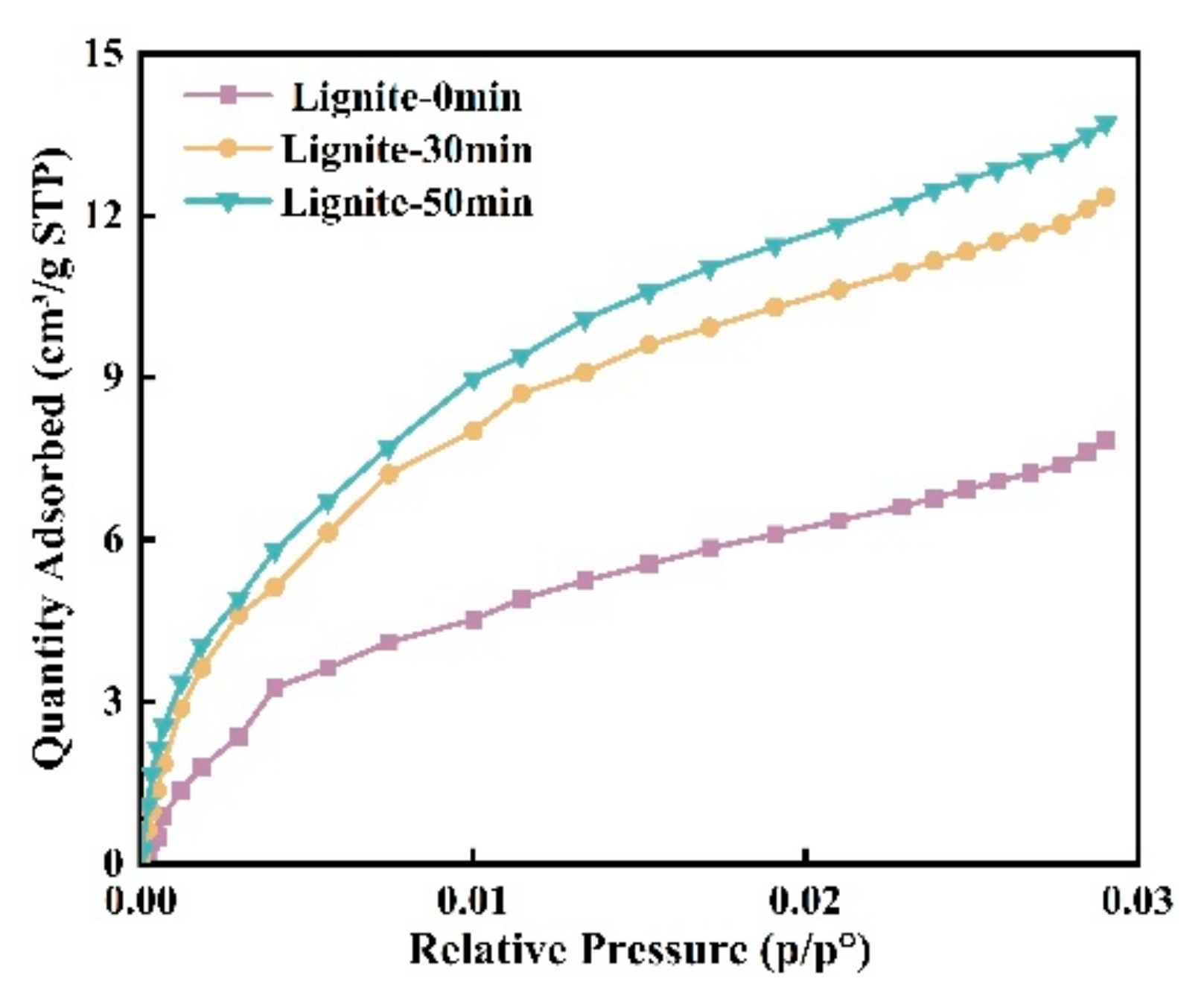




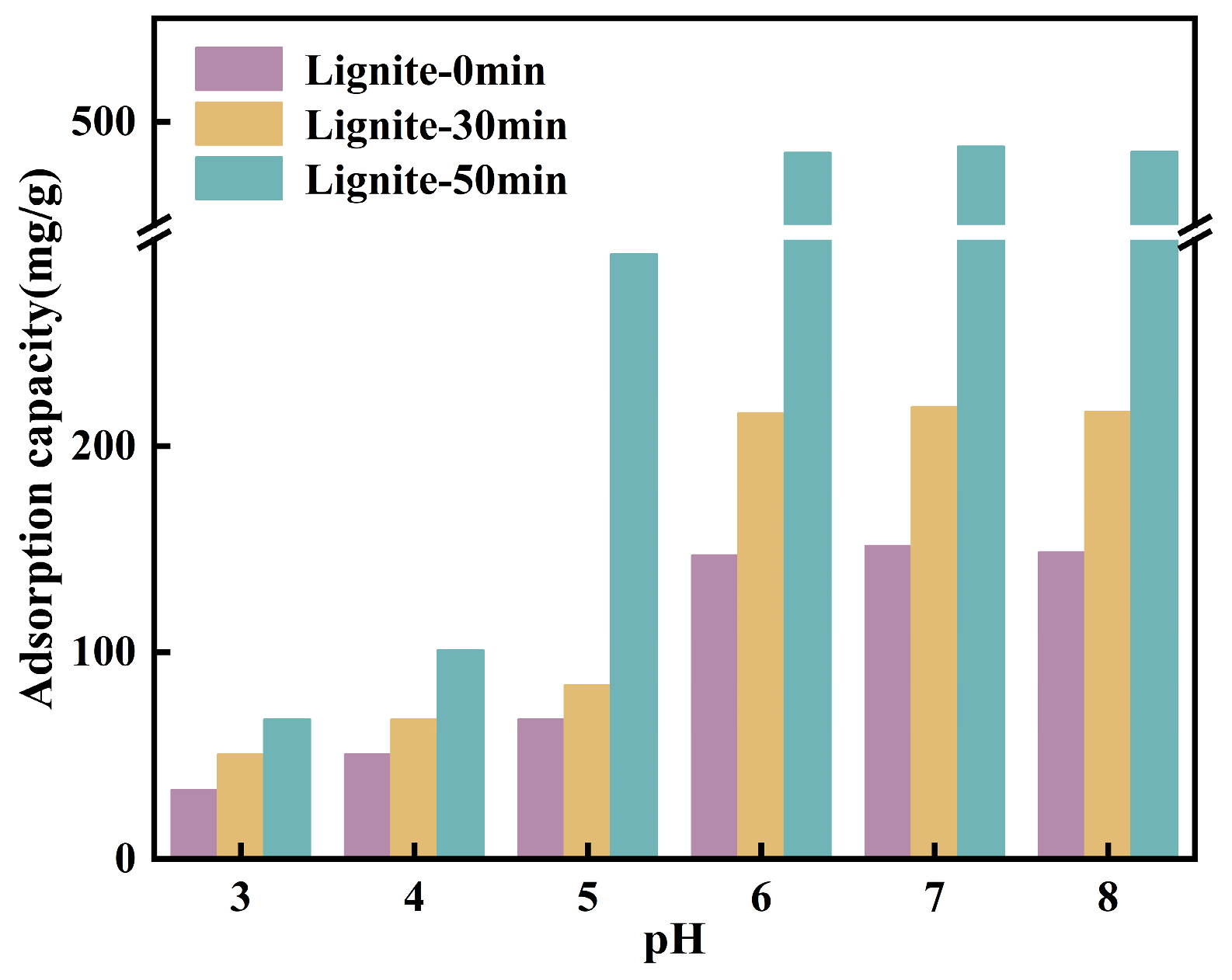
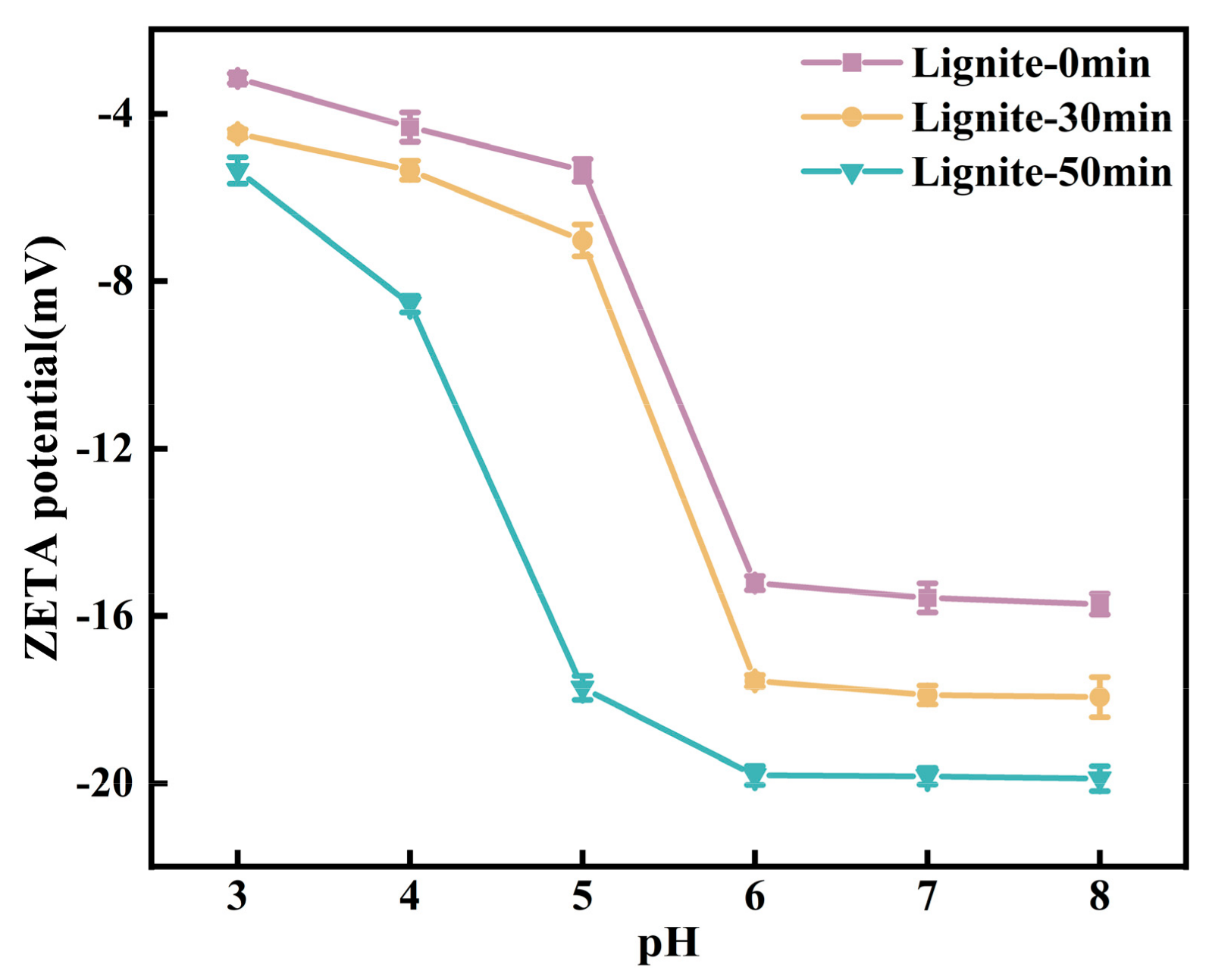
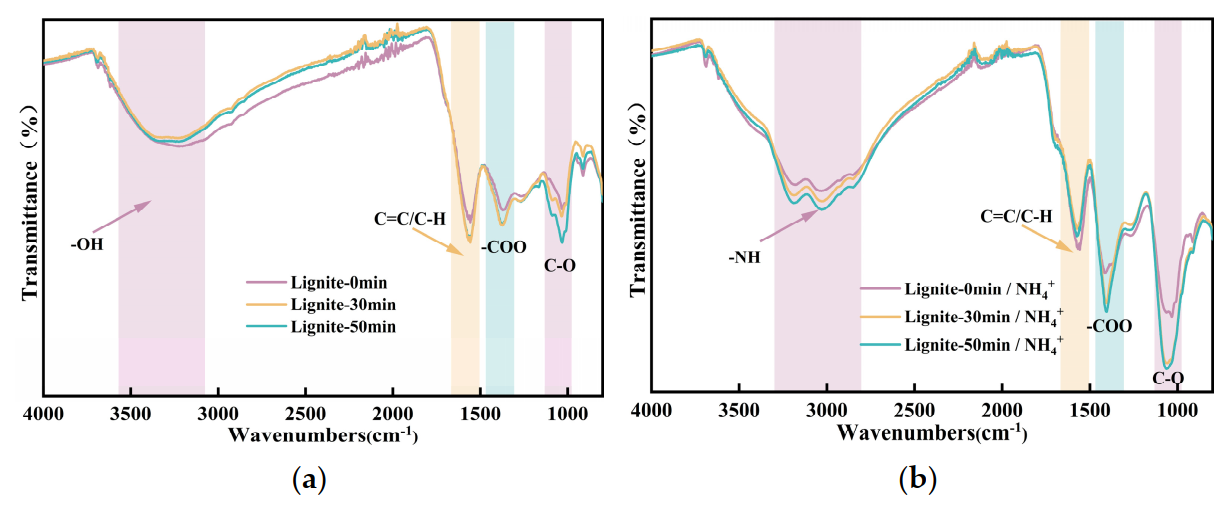


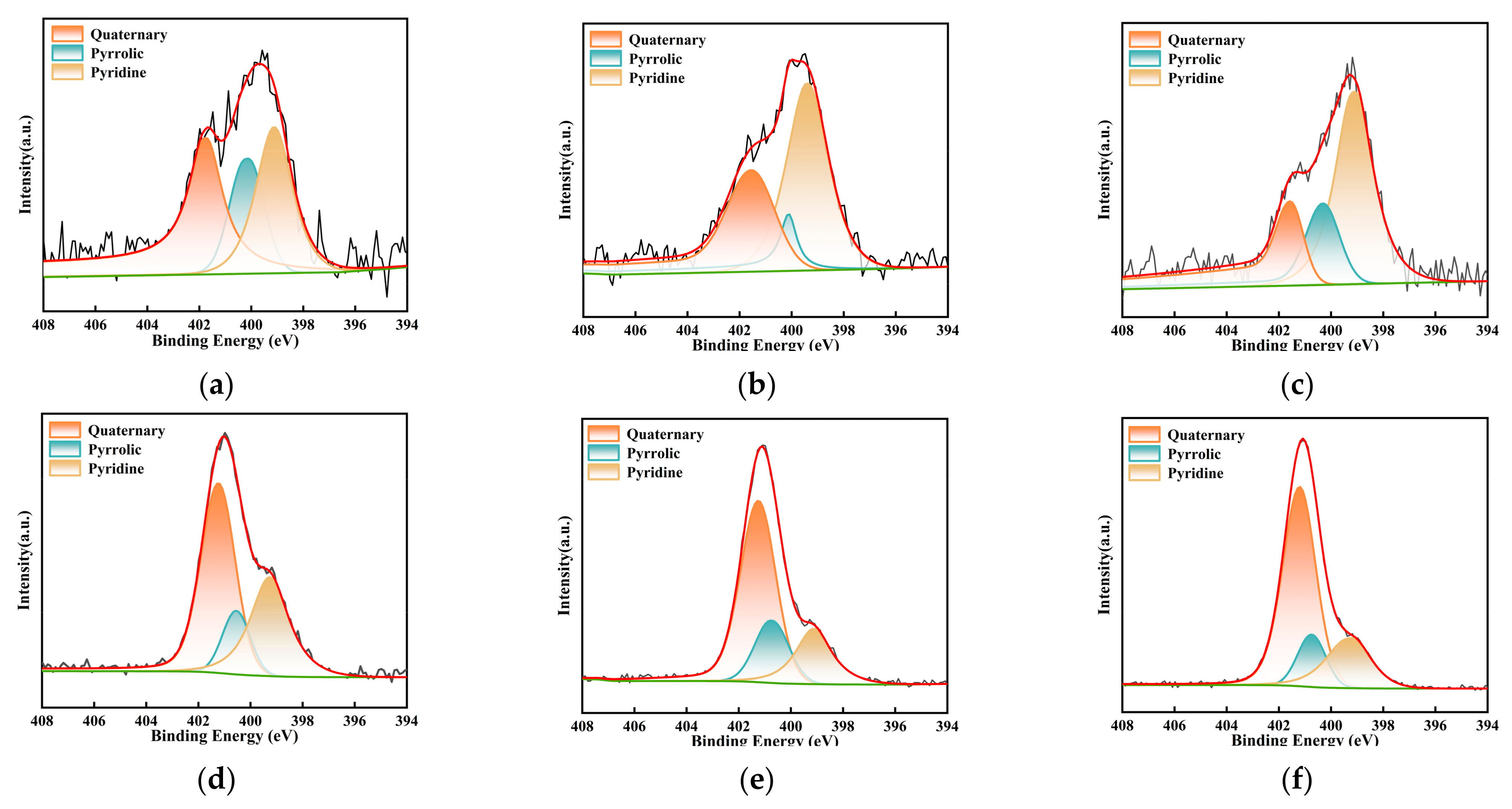
| Proximate Analysis (%) | Ultimate Analysis (%) | |||||||
|---|---|---|---|---|---|---|---|---|
| Mad | Aad | Vad | FCd | C | H | N | S | O |
| 11.49 | 17.66 | 48.32 | 36.62 | 45.00 | 3.64 | 1.00 | 0.49 | 35.49 |
| Sample | Nitrogen Adsorption | Carbon Dioxide Adsorption | |||
|---|---|---|---|---|---|
| BET Surface Area (m2/g) | Pore Volume (cm3/g) | Mesopore Volume (cm3/g) | Surface Area (m2/g) | Micropore Volume (cm3/g) | |
| Lignite-0 min | 2.6624 | 0.0134 | 0.0028 | 59.469 | 0.0104 |
| Lignite-30 min | 6.1744 | 0.0241 | 0.0080 | 96.552 | 0.0186 |
| Lignite-50 min | 8.1589 | 0.0418 | 0.0131 | 103.004 | 0.0216 |
| Biochar | Langmuir Model | Freundlich Model | ||||
|---|---|---|---|---|---|---|
| qm | kl | R2 | Kf | 1/n | R2 | |
| Lignite-0 min | 203.795 | 0.526 | 0.958 | 66.665 | 0.469 | 0.904 |
| Lignite-30 min | 250.072 | 1.247 | 0.992 | 118.605 | 0.552 | 0.942 |
| Lignite-50 min | 860.503 | 0.264 | 0.975 | 171.375 | 0.618 | 0.954 |
| Biochar | Pseudo-First-Order Kinetic Model | Pseudo-Second-Order Kinetic Model | ||||
|---|---|---|---|---|---|---|
| k1 | qe | R2 | k2 | qe | R2 | |
| Lignite-0 min | 0.026 | 149.824 | 0.978 | 0.00021 | 165.569 | 0.986 |
| Lignite-30 min | 0.027 | 219.966 | 0.975 | 0.00023 | 243.752 | 0.985 |
| Lignite-50 min | 0.0135 | 498.545 | 0.991 | 0.00003 | 584.777 | 0.993 |
| Sample | Carbon Form Contents (%) | |||
|---|---|---|---|---|
| C-C/C-H | C-N | C-O | COOH | |
| Lignite-0 min | 66.23% | 9.93% | 13.91% | 9.93% |
| Lignite-0 min/NH4+ | 58.18% | 13.30% | 16.28% | 12.21% |
| Lignite-30 min | 61.73% | 11.11% | 15.43% | 11.73% |
| Lignite-30 min/NH4+ | 44.64% | 24.55% | 15.18% | 15.63% |
| Lignite-50 min | 58.82% | 11.18% | 18.24% | 11.76% |
| Lignite-50 min/NH4+ | 43.67% | 28.38% | 14.85% | 13.10% |
| Sample | Nitrogen Form Contents (%) | ||
|---|---|---|---|
| N-6 | N-5 | N-Q | |
| Lignite-0 min | 31.59% | 21.22% | 47.19% |
| Lignite-0 min/NH4+ | 32.76% | 13.36% | 53.88% |
| Lignite-30 min | 49.73% | 12.30% | 37.98% |
| Lignite-30 min/NH4+ | 26.29% | 12.66% | 61.05% |
| Lignite-50 min | 51.53% | 20.75% | 27.73% |
| Lignite-50 min/NH4+ | 21.85% | 13.55% | 64.60% |
Disclaimer/Publisher’s Note: The statements, opinions and data contained in all publications are solely those of the individual author(s) and contributor(s) and not of MDPI and/or the editor(s). MDPI and/or the editor(s) disclaim responsibility for any injury to people or property resulting from any ideas, methods, instructions or products referred to in the content. |
© 2024 by the authors. Licensee MDPI, Basel, Switzerland. This article is an open access article distributed under the terms and conditions of the Creative Commons Attribution (CC BY) license (https://creativecommons.org/licenses/by/4.0/).
Share and Cite
Zhang, S.; Fan, Y.; Dong, X.; Ma, X.; Yang, M.; Xiao, W. Preparation and NH4+ Adsorption Performance of Ultrafine Lignite-Based Porous Materials. Separations 2024, 11, 40. https://doi.org/10.3390/separations11020040
Zhang S, Fan Y, Dong X, Ma X, Yang M, Xiao W. Preparation and NH4+ Adsorption Performance of Ultrafine Lignite-Based Porous Materials. Separations. 2024; 11(2):40. https://doi.org/10.3390/separations11020040
Chicago/Turabian StyleZhang, Siyuan, Yuping Fan, Xianshu Dong, Xiaomin Ma, Maoqing Yang, and Wei Xiao. 2024. "Preparation and NH4+ Adsorption Performance of Ultrafine Lignite-Based Porous Materials" Separations 11, no. 2: 40. https://doi.org/10.3390/separations11020040






